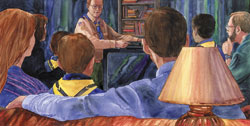![]() March-April 2001
March-April 2001
By Bill Sloan
Illustration by Bob Dacey

Child sexual abuse claims 500,000 victims in the United States every year. One in seven boys could be victimized before reaching adulthood, and the percentage of sexually abused girls is even greater.
To reduce this toll, the BSA Task Force on Youth Protection has designated April as "Youth Protection Month," with the goal of involving every traditional Scouting unit in an effort to alert and educate children and adults alike.
April was chosen because it comes just before school vacations and the many outdoor summer activities that accentuate the need for child protection.
The message at the heart of the campaign is an updated version of the "Three R's":
Recognize—Children need to know the strategies and situations child molesters use--and to understand that a molester can be anyone.
Resist—Because few molesters resort to force, resistance can thwart most attempts at abuse.
Report—Children should be encouraged to tell their parents or other trusted adults about any attempted sexual abuse.
"We're committed to take every possible step to limit the opportunities for child abuse," said Brad Farmer, BSA national director of Cub Scouting and coordinator of the Youth Protection Month campaign.
"The campaign has two major goals," Farmer said. "One is to get every Cub Scout pack, Boy Scout troop, and Venturing crew to conduct a unit youth protection program. The other is to re-emphasize Scouting's role as a leading advocate of child safety, not only among its own membership but also in the community at large.
"We can accomplish the latter by sharing our resources through community partnerships with other youth organizations. This will allow our message to reach hundreds of thousands of non-Scout families as well."
The BSA task force has been laying the groundwork for the campaign since last fall.
"All councils have received special planning and promotion kits, to use during their annual first-quarter planning conference to organize local programs on a unit-by-unit basis," Farmer said. The kits include cover letters to council executives and sample letters for both unit leaders and Scout families.
Three BSA videos are the cornerstone of the campaign. Each is tailored to reach one of the principal age groups in Scouting, and each uses lifelike dramatizations to convey practical information on how children can protect themselves against abusers. Step-by-step guides on how to use the videos are also available.
The videos can be borrowed from local Scout council service centers or purchased, effective March 1, 2001, from the BSA National Distribution Center, P.O. Box 65989, Charlotte, NC 28265-0989. To place a credit card order, call (800) 323-0732.
"These award-winning videos offer much more than just training for Scouts and Scouters," Farmer emphasized. "They also teach life skills that benefit all children. They alert young people and adults to what has become a widespread problem in our society and explain in easily understood terms what they can do to combat it."
For years, Scouting has taken a leading role in protecting children and youth against sexual abuse. Every handbook for Cub Scouts and Boy Scouts includes a removable supplement called "How to Protect Your Children from Child Abuse: A Parent's Guide." Manuals for volunteer Cub Scout, Boy Scout, and Venturing leaders contain a chapter on youth protection guidelines. And a comprehensive 90-minute Youth Protection training program prepares adults to conduct activities in accordance with BSA youth protection guidelines.
However, to eliminate more than ever the potential for child abuse, a more concerted, unified effort is needed, Farmer said.
"I was happy to head up this campaign," he said. "We've taken many steps within Scouting to protect youngsters, but if we're going to make our overall communities safer places for our kids, we need to do more."
Bill Sloan is a Scouting magazine contributing editor.
Copyright © 2001 by the Boy Scouts of America. All rights thereunder reserved; anything appearing in Scouting magazine or on its Web site may not be reprinted either wholly or in part without written permission. Because of freedom given authors, opinions may not reflect official concurrence.
| The Boy Scouts of America | http://www.scouting.org |